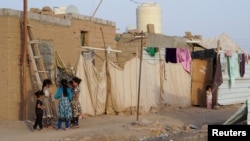The U.N. World Food Program says it is scaling up assistance for millions of people on the verge of famine in parts of Yemen.
More than 24 million people or 80 percent of Yemen’s population need humanitarian assistance. The World Food Program is already supporting nearly 13 million people with emergency food aid.
However, not all beneficiaries receive equal treatment. Because the agency is running low on cash, it is forced to prioritize areas with the highest rates of food insecurity. Consequently, it says it is expanding food assistance in Yemen’s worst hunger hotspots, which are in greatest need.
WFP spokesman Tomson Phiri says the aim is to prevent the most vulnerable from slipping into famine conditions.
“Fifty-thousand people in the country are facing famine-like conditions. Five million are just a step away from famine and they might even fall into famine if conditions worsen…And around half of all children under the age five—equivalent to 2.3 million -- still projected to face acute malnutrition in 2021,” Phiri said.
UNICEF says malnutrition rates among women and children in Yemen remain among the highest in the world. Severe acute malnutrition can cause stunted growth in children and affect their physical and cognitive development.
Last year, lack of money forced the WFP to cut food aid in half. In April it stopped monthly food distribution. Instead, people in the hard-hit northern areas of Yemen have been receiving food aid every two months.
In February, the WFP resumed monthly food assistance to 350,000 people in districts facing famine-like conditions. It gradually increased aid in April and May to nearly six million people in nine areas facing acute hunger.
Though it continues to operate on a shoestring, the WFP says it will resume monthly distributions of full rations to beneficiaries in those areas as of June.
So far this year, it reports donors have contributed nearly $947 million. While that is good news, the U.N. food agency says it still falls far short of the $1.9 billion it needs to avert famine in Yemen this year.










